
The future of musical theater is in good hands with talented students like those from USC who have put together a sensational black box production of Sondheim/Lapine’s Sunday In The Park With George, a production which actually surpasses last year’s outstanding Sunday/George at The Chance Theatre in both imagination and originality. This is due in large part to director/set designer Steve Edlund, aided by a fine cast and a star making performance by Natalie Peyser.
Musical Theatre Repertory’s Edlund has designed a mobile white-walled set which spans the wide Massman Theatre stage and takes shape before our eyes as a modern day, denim clad George utters the memorable opening lines, “White. A blank page or canvas. The challenge: bring order to the whole. Through design. Composition. Tension. Balance. Light. And harmony.” A large blank screen upstage begins to fill, like a giant Etch-A-Sketch, with lines which begin to represent Seurat’s most famous work, “Sunday Afternoon on the Island of La Grande Jatte.” Later on, the pencil lines become charcoal, with shadings of gray, and eventually fill with color and light.
For the few uninitiated, Sunday In The Park With George is the story of 19th century French painter George Seurat, his fictitious model/muse Dot, and (in act 2) Seurat’s 20th century great-grandson also called George, and his grandmother Marie, the elderly daughter of the first George and Dot. Its themes are “art, emotional connection, and community.” (Wikipedia.org)
In the role of Dot, Edlund has cast Natalie Peyser, an actress/singer of great confidence and talent who more than holds her own again recent performances by Broadway’s Kelli O’Hara at Reprise! and the Chance’s talented Lowe Taylor. Peyser conveys Dot’s tenderness, and her charm. “I can read,” she exclaims insistently, and then in the tiniest voice, “a little.” At times, she is nearly incandescent. Even when Peyser is sharing the stage, you can’t take your eyes off her. In a fine scene with Tara Panattoni as Yvonne, Peyser is particularly strong as she mocks Yvonne’s affectations (and Panattoni is very good indeed as she reveals Yvonne’s insecurities). In act 2, a gray haired Peyser returns as modern George’s 90something grandmother, Marie, her eyes shimmering with memories, her voice quavering as she sings a heart-wrenching “Children and Art.” Remember the name Natalie Peyser. You’ll be hearing it again for sure.
As both 19th century George and his modern namesake, DJ Cashmere has the harder task, as the role(s) of George put vocal demands on even the best tenor, and there is always the memory of Mandy Patinkin’s almost unnaturally high and pure voice on the original cast recording. Cashmere gives it his all, and conveys George’s passion verging on obsession in “Finishing the Hat.” He is especially good in “The Day Off,” as tough Spot and saucy Fifi (two canines), down on his hands and knees, sniffing the ground, and creating two very different voices for the pooches. Cashmere does some fine and credible acting as contemporary George.
A real standout in the production is Laura Darrell in a pair of very different characterizations. With the help of some excellent aging makeup, Darrell is believable and touching as George’s elderly mother, reappearing in Act 2 glamorized as wealthy art maven Blair Daniels. Darrell, who sings “Beautiful” … beautifully and with deep feeling, has a solid career ahead of her as a musical theater character actress.
Handsome Keith Barletta is suitably oily as the lecherous Franz. In a very clever bit, Franz, seated on the grass next to a standing Nurse slips his hand under her floor length skirt and up her leg as he whispers seductively, “It’s too hot.” Sydney Blair Friedman is Franz’s wife Frieda, very funny as she and Franz strike a pose when they discover George painting them, and later reacting to the stench of the boatman (an appropriately surly and vulgar Jonathan Shell).
Ben Trustman is very good as the supercilious Jules, with his handlebar mustache and giggly wife, an equally good Tara Panattoni. James Grosch is excellent as Louis, the baker, whose sweet smile makes one almost forget that he’s not the brightest bulb. Grosch returns effectively in Act 2 as modern George’s close friend Dennis.
One of director Edlund’s original touches (or at least one I’d never seen before) is the clear differentiation between the two Celestes. Wearing completely dissimilar costumes, these are clearly two very distinct young women. Celeste # 1 (Greta McAnany) is the Alpha Celeste, taking great pleasure in bossing the sweeter, more subservient Celeste # 2 (Ashley Strumwasser) around, even hitting her with her umbrella when #2 is a bit insubordinate. #2 knows well enough not to let #1 sit on the grass without cleaning the ground with her handkerchief, and when #1 is seated, she makes sure to hold her umbrella straight above her head leaving poor #2 to sit unprotected from the sun. McAnany never overplays Celeste’s bossiness, and the lovely Strumwasser would seem to be just right for future roles as Laurey in Oklahoma and Julie in Carousel.
Brad Wergley is funny (so cute and yet so dim) as the “human” soldier, his bosom buddy comrade in arms represented by a blurred charcoal drawing on a human-sized cutout. Kelly Combs does very well as bratty Louise, and as modern George’s ex-wife Elaine.
Comic relief is provided in the characters of Mr. and Mrs., American tourists (presumably from George W. Bush country or thereabouts), wonderfully portrayed by Sean Kranz and Ashley Wright. Wright has the good luck to get to play three roles, all of them with flair. In addition, she’s the Irish nurse and in Act 2 reappears as the gregarious Harriet Pawling.
Director Edlund shows special skill in maneuvering his 15-actor cast around the stage, and especially in group scenes like the end of act 1 mayhem which George stops with a shouted “Order!”, leading to a moving rendition of Sondheim’s exquisite “Sunday” with “Sunday Afternoon on the Island of La Grande Jatte” filling the stage from left to right as the actors strike the painting’s inhabitant’s distinctive poses.
One of the stumbling blocks productions of Sunday In The Park With George face is the sometimes awkward transition from act 1’s 1887 setting and the more contemporary act 2’s 1984 time frame. Edlund’s set helps greatly in making this transition, as it transforms effortlessly from park to art gallery.
The same upstage screen which held Seurat’s “Grande Jatte” painting now projects a lightning fast montage of famous paintings, spanning every year between 1887 and 1984 in machine-gun rapid succession. Yet another of Edlund’s innovative ideas.
The Chromolume presentation is very effectively executed with a giant hollow Plexiglas crystal center stage, housing a half dozen or so colored rotating spotlights, while a laser light show takes place above the set, accompanied by electronica music.
Speaking of music, the very talented musical director Billy Thompson (composer of Invasion The Musical, costar of Twist, and USC grad) makes beautiful music at the piano, aided by Alexander Gerogakis on keyboard 2. Rarely has a single piano sounded so “big” and flawless.
Nick Handley’s lighting design is very effective, notably in a scene where Dot sits at her desk powdering herself, bathed in a celestial white light, George’s portrait of her in this same pose propped against the wall behind her. In the background a nearly crazed George stands behind a transparent scrim on which he adds dots of color to his signature painting, all the while singing “Dot Dot sitting, Dot Dot waiting, Dot Dot getting fat fat fat…” Excellent lighting aiding in creating a powerful scene.
Costumes are at a highly professional level, with credit due to Peyser for the first act’s intricately designed and beautifully executed 19th century fashions, including a hand-made bustle for Dot and the most god-awful feathered hat you’ve ever seen for Mrs., the obnoxious American tourist. Sara Fox designed act 2’s 80s fashions, which are perfect recreations of the big-shouldered look of 20 years ago. The women all have absolutely spot-on 80s hair as well.
Jesse Laks contributed the excellent sound and projection design, Griffin Behm was laser designer, Joe Sofranko choreographed the fights, and Paul Backer was vocal/dialect coach. Others involved behind the scenes included Melissa Trupp, Kim Parch, Kaitlyn Lee, Kate Thomas, Liza Burnes, Brittany Perham-MacWhorter, Sarah Morris, Carmen Smith, Jordan Schames, Sarah Steinman, Catherine Jeffrey, Brent Lomas, and Lili Fuller.
Seeing a student production always requires some additional suspension of disbelief, with young actors (in this case averaging around 20 years old) often playing roles which, once they enter the world of professional theater, they won’t get the chance to perform again for another 20 or 30 years. But it’s also exciting as an audience member to see glimpses into the kinds of roles the future holds for these performers.
This USC student production of Sunday In The Park With George competes quite favorably with many of the finest 99-seat theater productions I’ve seen over the past several years. If you have the time this weekend, do yourself a favor and catch this “Sunday” before Monday rolls around and it is no more.
USC Massman Theatre, 1029 Childs Way, Los Angeles
–Steven Stanley
January 24, 2008

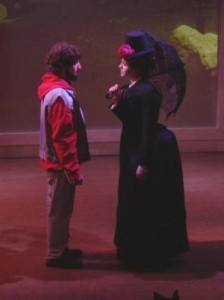
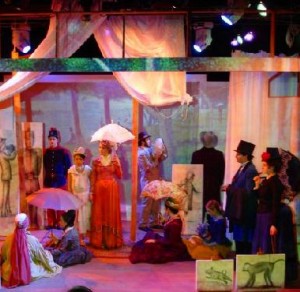
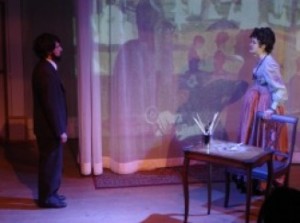
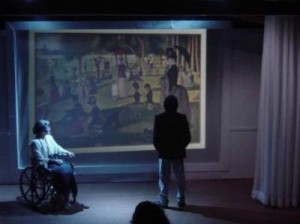
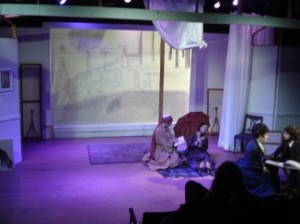
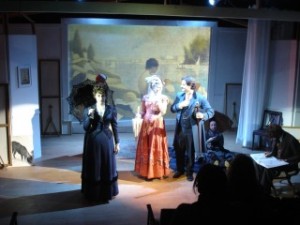

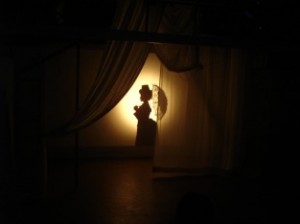

 Since 2007, Steven Stanley's StageSceneLA.com has spotlighted the best in Southern California theater via reviews, interviews, and its annual StageSceneLA Scenies.
Since 2007, Steven Stanley's StageSceneLA.com has spotlighted the best in Southern California theater via reviews, interviews, and its annual StageSceneLA Scenies.







 COPYRIGHT 2024 STEVEN STANLEY :: DESIGN BY
COPYRIGHT 2024 STEVEN STANLEY :: DESIGN BY